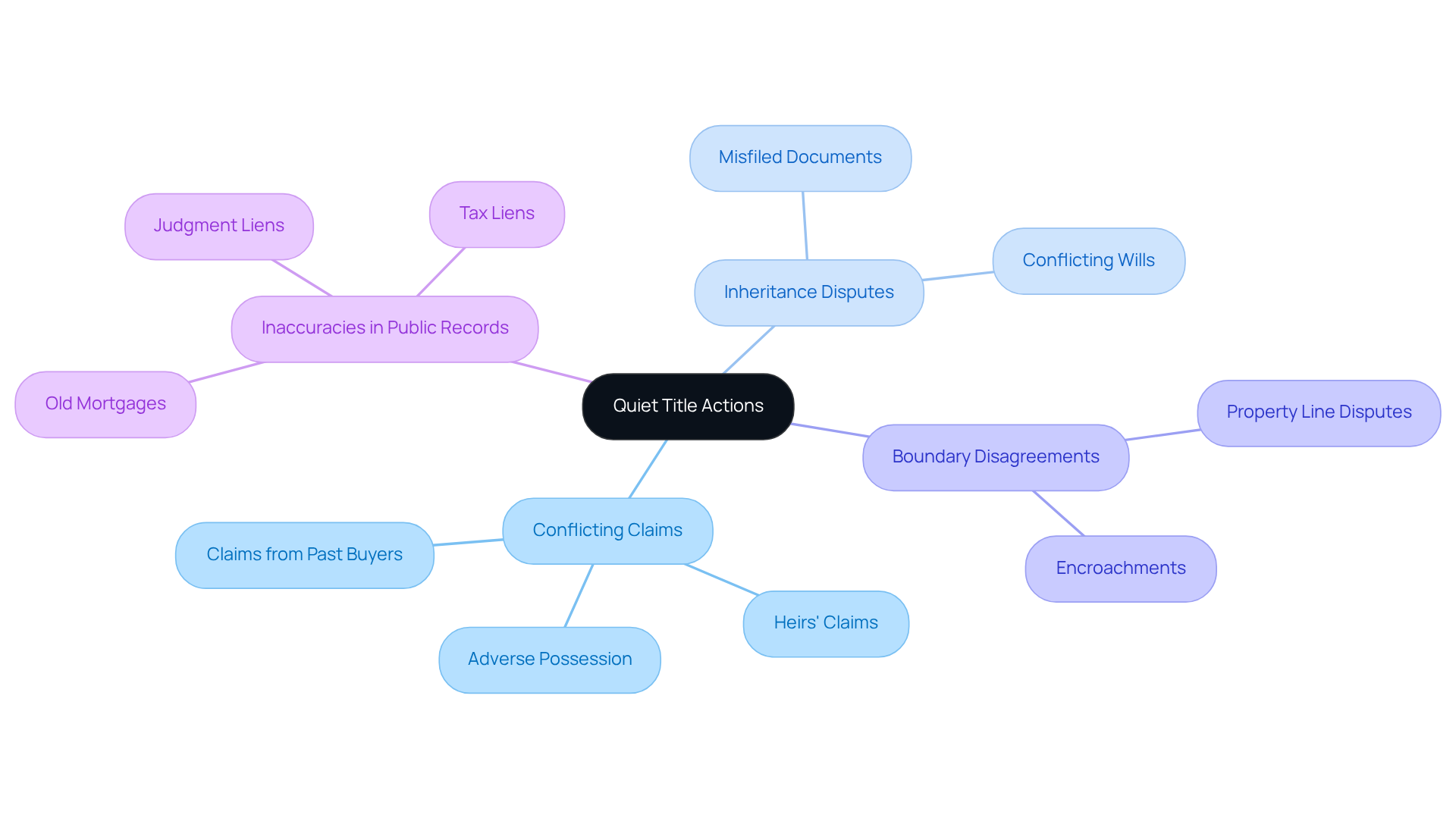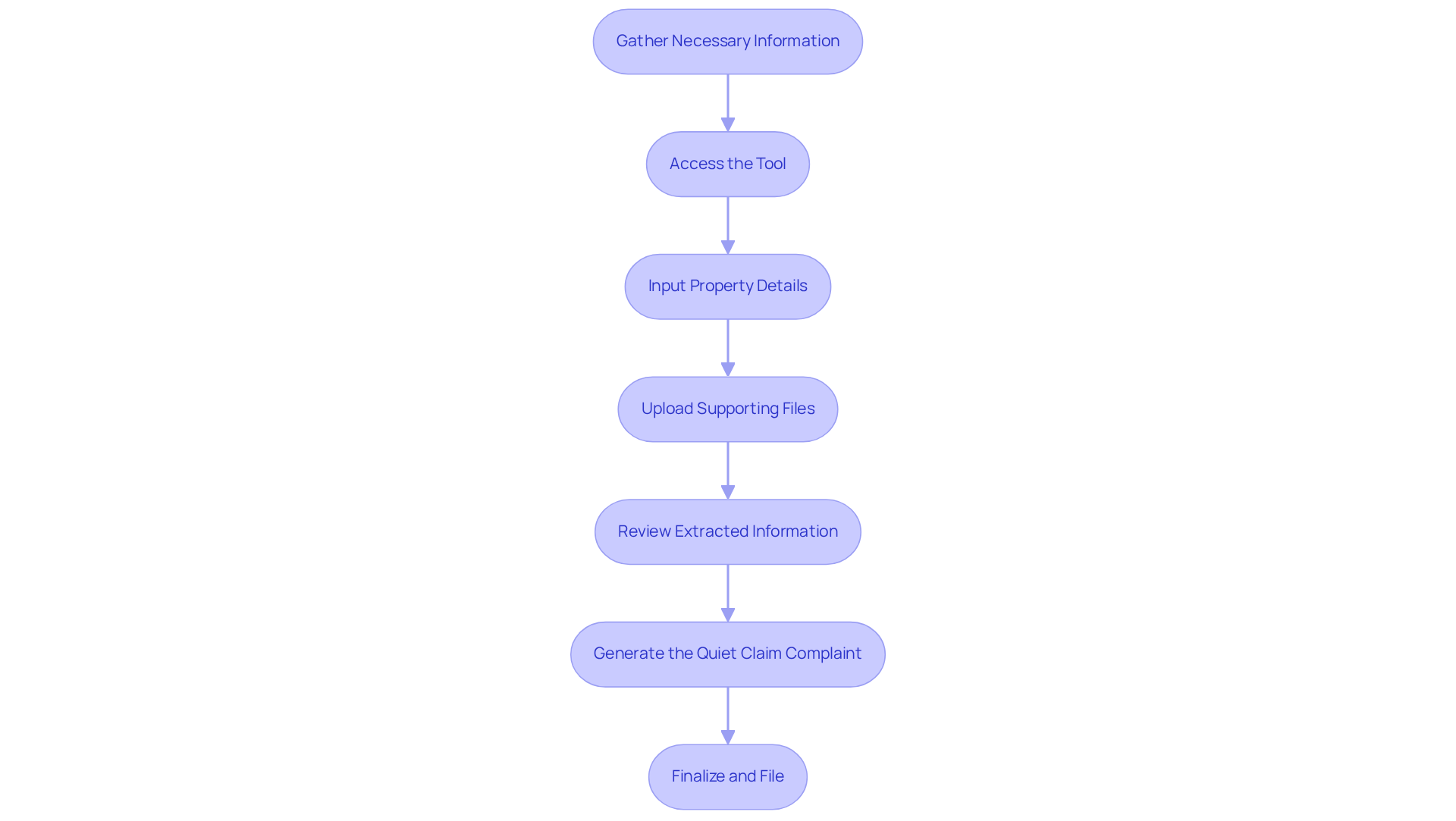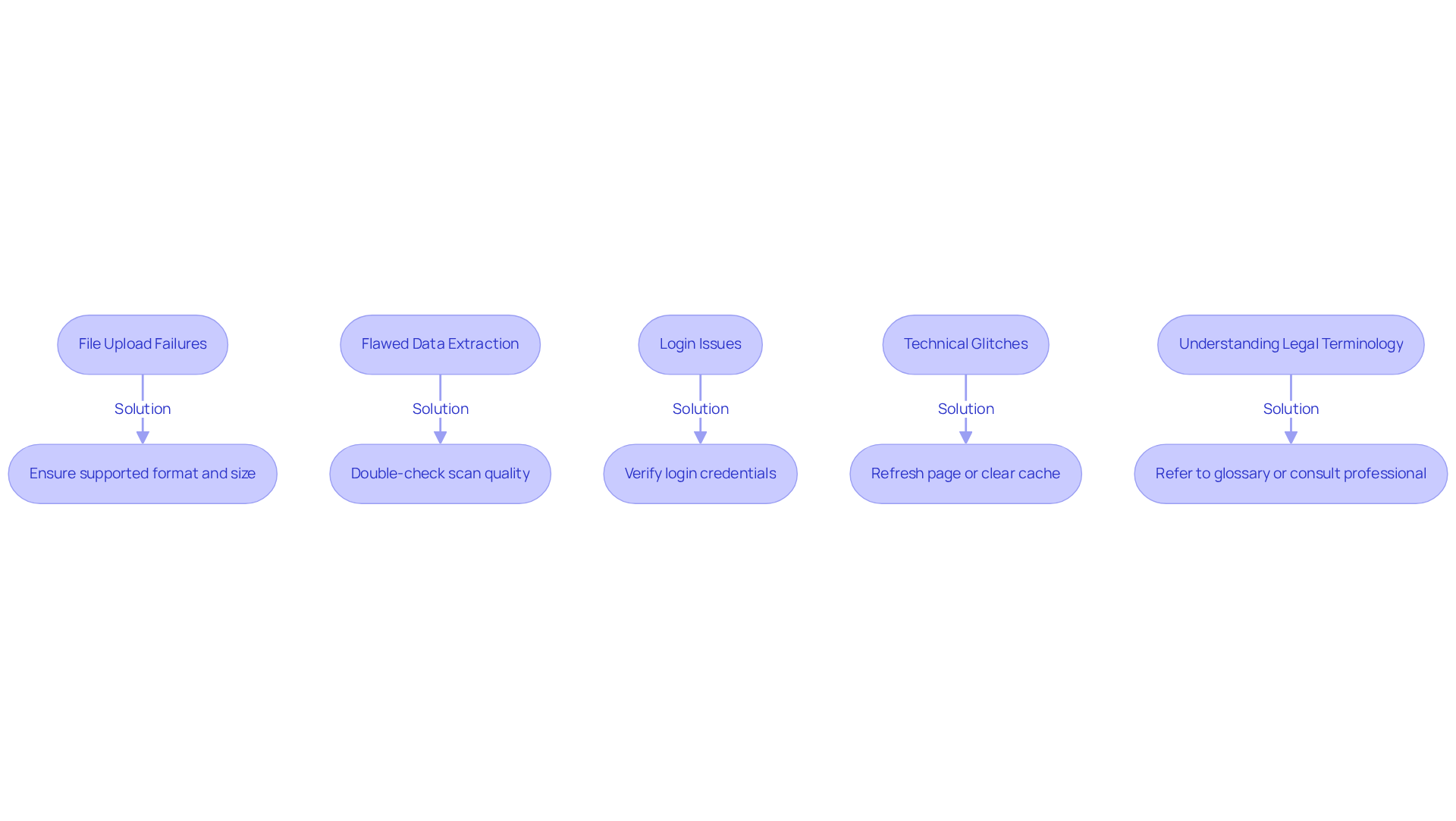Overview
The article delves into the effective utilization of the Quiet Title Document Tool, aimed at streamlining the resolution of real estate ownership disputes. It provides a comprehensive step-by-step guide that underscores the critical importance of accurate documentation. Additionally, it offers troubleshooting tips, illustrating how this tool can markedly enhance operational efficiency for real estate professionals. By minimizing errors and conserving time in the quiet title process, the tool proves to be an invaluable asset.
Introduction
Navigating the complexities of real estate ownership often resembles traversing a minefield, particularly when disputes arise over property titles. The quiet title action serves as a crucial legal remedy, specifically designed to resolve conflicting claims and secure rightful ownership. This article delves into the invaluable benefits of mastering the Book Trial of Quiet Title Document Tool, empowering real estate professionals to streamline their processes and mitigate risks.
As the intricacies of property law unfold, one must consider:
- What common pitfalls exist in utilizing this tool?
- How can they be effectively navigated to ensure a successful outcome?
Understand Quiet Title Actions
A quiet legal proceeding is an essential process aimed at settling conflicts over real estate ownership. This process effectively 'quiets' any competing claims against the ownership, affirming the rightful owner's legal standing. Such measures are particularly vital in situations involving:
- Conflicting claims
- Inheritance disputes
- Boundary disagreements
- Inaccuracies in public records
For instance, in Florida, adverse possession regulations enable individuals to assert ownership after occupying a property without consent for a designated duration, often requiring a quiet legal process to confirm rightful ownership.
The significance of quiet property proceedings cannot be overstated, as they offer clarity and security in real estate transactions. They assist in resolving approximately 70% of property conflicts, ensuring that ownership is free from encumbrances like old mortgages or tax liens that may still be present in public records. A thorough search of ownership is crucial before initiating a quiet claim process, as it allows you to book trial of quiet title document tool, revealing current claims, liens, or encumbrances linked to the property.
At Parse AI, founded by a team with over 50 years of combined experience in energy, real estate, and technology, we leverage our expertise and innovative technology to streamline this process. Our platform enhances the quiet claim process by offering a book trial of quiet title document tool along with advanced tools for comprehensive searches and effective management of these procedures. Seeking legal expertise is recommended, as seasoned attorneys can navigate the intricacies of these cases, interpret complex issues, and advocate for the claimant's interests. Ultimately, understanding the subtleties of quiet ownership claims is vital for , enabling more seamless transactions in the market and safeguarding property rights.

Utilize the Quiet Title Document Tool: Step-by-Step Process
To effectively utilize the Quiet Title Document Tool, follow these steps:
- Gather Necessary Information: Collect all relevant documents related to the property, including previous title deeds, surveys, and any correspondence regarding ownership disputes. This foundational step is crucial, as incomplete documentation can lead to prolonged litigation or case dismissal.
- Access the Tool: Log into the Quiet Title Document Tool on the Parse AI platform. Ensure you have the necessary permissions to access the resource, which is designed to enhance workflow efficiency for real estate professionals.
- Input Property Details: Enter the property address and any other required information into the tool. This may include details about previous owners and any claims against the title, which are essential for establishing a clear ownership claim.
- Upload Supporting Files: Utilize the upload feature to attach scanned copies of the collected materials. The tool's optical character recognition capabilities will assist in extracting relevant data, significantly reducing the time spent on manual data entry and minimizing errors.
- Review Extracted Information: Once the files are processed, examine the extracted information for accuracy. Considering that inadequate record management contributes to 21.3% of productivity loss and employees devote 30% of their time seeking files, ensuring data accuracy is essential for efficient decision-making.
- Generate the Quiet Claim Complaint: Utilize the tool to produce a draft of the quiet claim complaint. This file will detail your claim and the foundation for the quiet title lawsuit, streamlining the preparation process and improving the quality of submissions.
- Finalize and File: After reviewing the draft, finalize the document and file it with the appropriate court. Ensure you follow local court rules regarding filing procedures and fees, as adherence to these regulations is critical for the success of your action.
By using the book trial of quiet title document tool, real estate professionals can save significant time and reduce errors in the quiet title process, ultimately enhancing their operational efficiency and client satisfaction. As highlighted in industry insights, "the management sector is profitable, saving businesses time and money," which emphasizes the importance of incorporating such resources in .

Troubleshoot Common Issues with the Tool
Users may encounter several common issues while utilizing the book trial of quiet title document tool. Here are troubleshooting tips to address them effectively:
- File Upload Failures: Should you experience difficulties uploading files, ensure they are in a supported format (e.g., PDF, JPEG) and do not exceed the size limit. Compress larger files or convert them to a compatible format to facilitate successful uploads. Notably, statistics reveal that nearly 80% of organizations grapple with outdated digital technologies, contributing to such upload challenges. Proactively addressing these issues can significantly enhance your experience when using the book trial of quiet title document tool.
- Flawed Data Extraction: If the software misinterprets information from your files, it is essential to double-check the quality of the scanned images. Clear and legible scans are critical. Should issues persist, manually input the data where necessary to ensure accuracy. Expert advice indicates that improving document quality can substantially reduce extraction errors, leading to more favorable outcomes in your title research.
- Login Issues: In the event that you cannot access the application, verify your login credentials. Utilize the password recovery option if you have forgotten your password. Additionally, confirm that your account is active and possesses the necessary permissions to access the resource.
- Technical Glitches: For unexpected errors or crashes, refresh the page or clear your browser cache. If the problem continues, do not hesitate to reach out to customer support for further assistance. A case study on efficiency gains through technology underscores that promptly resolving technical issues can lead to improved productivity in legal workflows.
- Understanding Legal Terminology: If you encounter legal terms or phrases that are unclear, refer to the tool's glossary or consult with a legal professional. This will aid you in comprehensively grasping the implications of the materials you are handling. A proper understanding of legal terminology is vital for effective document management and can enhance your overall efficiency.
By proactively addressing these common problems, users can significantly enhance their experience and efficiency by booking a trial of .

Conclusion
Mastering the book trial of the Quiet Title Document Tool is essential for real estate professionals aiming to navigate the complexities of property ownership disputes. This guide underscores the critical role of quiet title actions in affirming rightful ownership and resolving conflicts stemming from competing claims, inheritance issues, and inaccuracies in public records. By effectively utilizing the Quiet Title Document Tool, users can streamline the process, ensuring their claims are well-documented and legally sound.
Key insights from this article detail the step-by-step process for employing the tool, from gathering necessary information to troubleshooting common issues. Each phase is crafted to enhance efficiency, reduce errors, and ultimately safeguard property rights. The importance of seeking legal expertise cannot be overstated, as experienced attorneys offer invaluable support in navigating this intricate landscape.
In conclusion, embracing the Quiet Title Document Tool not only optimizes workflows but also strengthens the legal foundations of real estate transactions. As the industry evolves, integrating such innovative resources will be imperative for professionals striving to maintain a competitive edge. Taking proactive steps to master this tool will ensure that property ownership disputes are resolved swiftly and effectively, paving the way for smoother transactions and enhanced client satisfaction.
Frequently Asked Questions
What is a quiet title action?
A quiet title action is a legal proceeding aimed at resolving disputes over real estate ownership by affirming the rightful owner's legal standing and 'quieting' any competing claims against the property.
Why are quiet title actions important?
They provide clarity and security in real estate transactions, helping to resolve approximately 70% of property conflicts and ensuring ownership is free from encumbrances such as old mortgages or tax liens.
In what situations are quiet title actions particularly vital?
They are crucial in cases of conflicting claims, inheritance disputes, boundary disagreements, and inaccuracies in public records.
How do adverse possession regulations relate to quiet title actions?
In states like Florida, adverse possession allows individuals to claim ownership of a property after occupying it without consent for a specific period, often requiring a quiet title action to confirm their legal ownership.
What is the significance of conducting a thorough ownership search before a quiet title action?
A thorough search reveals current claims, liens, or encumbrances linked to the property, which is essential for effectively initiating a quiet claim process.
How does Parse AI assist in the quiet title process?
Parse AI offers a book trial of quiet title document tool and advanced resources for comprehensive searches and effective management of quiet title procedures, leveraging over 50 years of combined expertise in energy, real estate, and technology.
Why is it recommended to seek legal expertise when pursuing a quiet title action?
Experienced attorneys can navigate the complexities of quiet title cases, interpret intricate issues, and advocate for the claimant's interests, ensuring a more effective process.
Who can benefit from understanding quiet title actions?
Real estate experts and professionals can benefit from understanding quiet title actions, as it enables smoother transactions and helps safeguard property rights.




